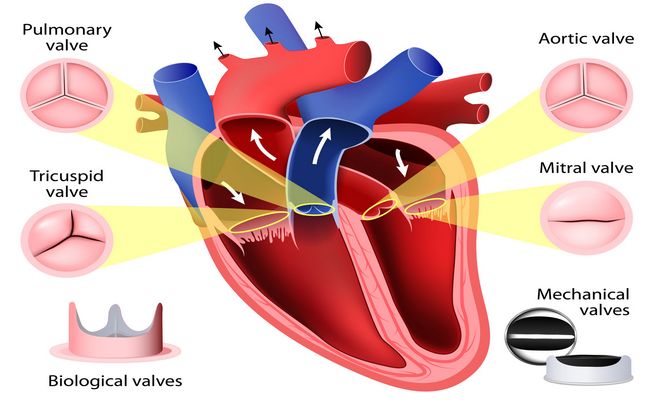What is Heart Valve Disease?
Valvular heart disease is characterized by the narrowing or leaking of any of those or more valves.
There are four values in the heart. Such as-
- Aortic valve,
- Mitral valve,
- Pulmonary valve,
- Tricuspid valve.

Types of Valvular Heart Disease:
There are two types of heart valve disease. Those are in the following with details:
Valvular Stenosis:
Valvular Stenosis results from a narrowing of the valve orifice that is usually caused by a thickening and increased rigidity of the valve leaflets. The narrowed opening may make the heart work very hard to pump blood through it. All four valves can be stenosis such as- Aortic stenosis, Mitral Stenosis, Tricuspid Stenosis, Pulmonic Stenosis.
Valvular Insufficiency:
Valvular Insufficiency results from the valve leaflets not completely sealing when the valve is closed so that a backward flow (Regurgitation) of blood occurs into the heart. Depending on which valve is affected, the condition is called tricuspid regurgitation, pulmonary regurgitation, mitral regurgitation, or aortic regurgitation.
Causes of Valvular Heart Disease or Valvular Heart Disease Causes:
There are different causes of heart valve disease. Those are in the following-
For Valvular Regurgitation:
- Congenital,
- Acute rheumatic Carditis,
- Hypertension,
- Valve ring dilatation (eg-dilated cardiomyopathy),
- Traumatic valve rupture,
- Senile degeneration,
- Damage to chordae and papillary muscle,
- Syphilitic aortitis,
- Mitral valve prolapsed,
- Systemic lupus erythematosus,
- Aortic aneurysm.
For Valvular Stenosis:
- Congenital,
- Rheumatic Carditis,
- Senile degeneration,
- Age,
- Atherosclerosis,
- Carcinoid tumors.
Sign and Symptoms of Valvular Heart Disease or Valvular Heart Disease Symptoms:
There are several signs and symptoms of heart valve disease. Those are in the below-
- Shortness of breath,
- Weakness or dizziness,
- Wheezing and heavy coughing,
- Physical exertion,
- Palpitations mild chest pain,
- Fever,
- Rapid weight gain,
- Swelling of the ankles, feet, or abdomen.
Diagnosis for Valvular Heart Disease:
The main diagnosis ways for heart valve disease are the following:
- ECG,
- Echocardiogram,
- Stress testing,
- Cardiac catheterization (Angiogram),
- Radionuclide scans.
Valvular Heart Disease Treatment:
Different treatment formulas for heart valve disease are in the below-
1. Lifestyle Modifications,
2. Medications:
- Antibiotic (To prevent bacterial endocarditis).
- Diuretics (remove extra fluid) – furosemide.
- Antiarrhythmic (control of the heart’s rhythm) -Lidocaine, Amiodarone.
- ACE Inhibitors (Reduce afterload by forwarding direction rather than backward through a leaky valve -Captopril, Enalapril.
- Beta-Blockers (Slow heart rate and improve cardiac output) – Metoprolol, Bisoprolol.
- Anticoagulants (prevent blood clot) – Heparin.
3. Surgery and procedures:
- Balloon dilatation
- Minimally – Invasive Atrial Septal defect closure.
- Minimally – Invasive valve repair and replacement.
- Minimally –Invasive Aortic valve replacement.
Prevention for Valvular Heart Disease:
There are different ways the prevention of heart valve disease. Those are in the below:
- Stop smoking.
- Consume no more than two alcoholic beverages a day.
- Eat a healthy, balanced diet (low salt and fat).
- Regular exercise and control weight.
- Maintain careful control of blood sugar.
Nursing Intervention for Valvular Heart Disease or Valvular Heart Disease Guidelines:
Nursing interventions for heart valve disease are in the below-
- Assess mental status (Restlessness, severe anxiety, and confusion).
- Check vital signs (heart rate and blood pressure).
- Assess heart sounds, noting gallops, S3, S4.
- Assess manually peripheral pulses (with weak rate, rhythm indicated low cardiac output).
- Assess lung sounds and determine any occurrence of Paroxysmal Nocturnal Dyspnea (PND) or orthopnea.
- Monitor central venous, right arterial pressure [RAP], pulmonary arterial pressure(PAP)
- Routinely Assess skin color and temperature (Cold, clammy skin is secondary to a compensatory increase in sympathetic nervous system stimulation and low cardiac output and desaturation).
- Carefully maintain intake output and daily check weight.
- Administer medication as prescribed, noting response, and watching for side effects and toxicity.
- Administer stool softeners as needed(straining for a bowel movement further impairs cardiac output).
- Explain the drug regimen, purpose, dose, and side effects.
- Maintain adequate ventilation and perfusion (Place the patient in semi- to high-Fowler’s position or supine position).
- Administer O2 as ordered.
- Assess response to increased activity and help the patient in daily activities.
- Maintain physical and emotional rest (restrict activity and provide a quiet and relaxed environment).
- Monitor sleep patterns; administer a sedative.
- If invasive adjunct therapies are indicated (e.g., intra-aortic balloon pump, pacemaker), maintain within the prescribed protocol, and prepare the patient.
- Explain diet restrictions (fluid, sodium).
More questions related to this topic:
- An Overview of Heart Valve Disease.
- Heart Valve Disease: Get facts on Symptoms and Treatment.
- Why Do We Have Valves in the Heart?
- What is a Leaky Heart Valve?
- Types of Valve Disease.
- What Causes the Valves to Open and Close?

Maria Khatun Mona is a Founder and Editor of Nursing Exercise Blog. She is a Nursing and Midwifery Expert. Currently she is working as a “Senior Staff Nurse” at “Dinajpur Medical College Hospital”, Bangladesh. She has great passion in writing different articles on Nursing and Midwifery. Mail her at “maria.mona023@gmail.com”

very helpfull